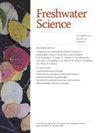淡水泛滥平原栖息地缓冲本地食物网免受非本地中脊蛙和牛蛙的负面影响
IF 1.6
4区 环境科学与生态学
Q3 ECOLOGY
引用次数: 1
摘要
物种引入在淡水环境中很常见,有可能改变群落和生态系统结构。捕食性中脊鱼类和美洲牛蛙(Lithobates catesbeianus Shaw,1802年以前为Rana catesbeiana)都是广泛分布的水生入侵者,与本土两栖动物的减少有关。在低地生态系统中,本地和非本地两栖动物和鱼类类群之间的共生现象很常见;然而,促进它们共同出现的机制研究得很少。稳定同位素分析为研究本地和非本地分类群之间的营养相互作用提供了一种工具,包括捕食、竞争和食物资源可利用性的变化,这可能为共现的驱动因素提供机制见解。在这项研究中,我们使用稳定同位素(δ13C和δ15N)来确定在美国华盛顿西南部的洪泛平原上,有和没有非本地中棘鱼和牛蛙的水体之间,本地鱼类和两栖动物的营养结构是如何不同的。我们假设本地物种改变了它们的觅食策略,以减少与非本地分类群的生态位重叠。在存在非本地分类群的情况下,三棘Stickleback(Gastrosteus acuretus Linnaeus,1758)、所有本地蝾螈幼虫物种(Ambystoma gracile Baird,1859和Ambystoma-macrobactylum Baird,1850)和两种本地蛙幼虫物种中的一种(Rana aurora Baird和Girard,1852)表现出食物资源或营养位置的变化。尽管存在营养差异,但只有1个物种(A.macrobactylum)在非本地物种的存在下具有较小的生态位大小。观察到的营养变化反映了栖息地或食物资源的变化,这可能会减少竞争或捕食,并促进非本地和本地分类群之间的共生。我们的研究结果表明,广泛的食物资源和复杂的栖息地结构可能促进了低地泛滥平原栖息地本地和非本地两栖动物和鱼类的共存。本文章由计算机程序翻译,如有差异,请以英文原文为准。
Freshwater floodplain habitats buffer native food webs from negative effects of nonnative centrarchids and bullfrogs
Species introductions are common in freshwater environments and have the potential to transform community and ecosystem structure. Predatory centrarchid fishes and American Bullfrogs (Lithobates catesbeianus Shaw, 1802 previously Rana catesbeiana) are both widespread aquatic invaders implicated in native amphibian declines. In lowland ecosystems, co-occurrence between native and nonnative amphibian and fish taxa is common; however, the mechanisms that facilitate their co-occurrence are poorly studied. Stable isotope analysis offers a tool to examine trophic interactions among native and nonnative taxa, including predation, competition, and shifting food resource availability, which may provide mechanistic insight into the drivers of co-occurrence. In this study, we used stable isotopes (δ13C and δ15N) to determine how the trophic structure of native fishes and amphibians differs between waterbodies with and without nonnative centrarchid fishes and bullfrogs across a floodplain in southwestern Washington, USA. We hypothesized that native species alter their feeding strategies to reduce niche overlap with nonnative taxa. In the presence of nonnative taxa, Three-spine Stickleback (Gasterosteus aculeatus Linnaeus, 1758), all native larval salamander species (Ambystoma gracile Baird, 1859 and Ambystoma macrodactylum Baird, 1850), and 1 of 2 native larval frog species (Rana aurora Baird and Girard, 1852) exhibited shifts in food resources or trophic position. Despite trophic differences, only 1 species (A. macrodactylum) had a smaller niche size in the presence of nonnatives. The observed trophic shifts reflect changes in habitat or food resources, which may reduce competition or predation and promote co-occurrence between nonnative and native taxa. Our results suggest that the co-occurrence of native and nonnative amphibians and fishes in lowland floodplain habitats may be facilitated by a broad range of food resources and complex habitat structure.
求助全文
通过发布文献求助,成功后即可免费获取论文全文。
去求助
来源期刊

Freshwater Science
ECOLOGY-MARINE & FRESHWATER BIOLOGY
CiteScore
4.10
自引率
0.00%
发文量
49
审稿时长
6-12 weeks
期刊介绍:
Freshwater Science (FWS) publishes articles that advance understanding and environmental stewardship of all types of inland aquatic ecosystems (lakes, rivers, streams, reservoirs, subterranean, and estuaries) and ecosystems at the interface between aquatic and terrestrial habitats (wetlands, riparian areas, and floodplains). The journal regularly features papers on a wide range of topics, including physical, chemical, and biological properties of lentic and lotic habitats; ecosystem processes; structure and dynamics of populations, communities, and ecosystems; ecology, systematics, and genetics of freshwater organisms, from bacteria to vertebrates; linkages between freshwater and other ecosystems and between freshwater ecology and other aquatic sciences; bioassessment, conservation, and restoration; environmental management; and new or novel methods for basic or applied research.
 求助内容:
求助内容: 应助结果提醒方式:
应助结果提醒方式:


